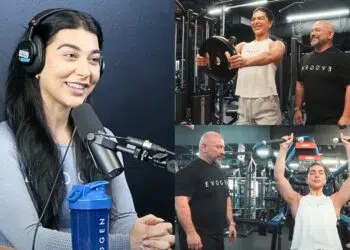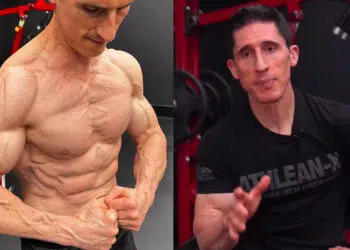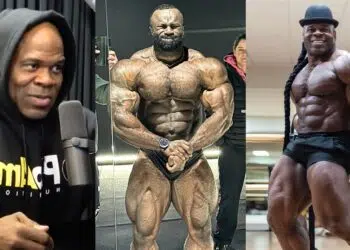Kai Greene has been pretty active (and generous) lately, sharing some of his elite-status workouts. ‘The Predator,’ who placed second at the Olympia in 2012, 2013, and 2014, shared his most intense arm workout earlier this month.
We also got to see what his current physique looks like in a recent posing video he released on his YouTube (relatively new channel). This would definitely lead many to believe that he’s planning a return to the big stage which he explained is “very possible,” last year. But chances are, he’d only do it if he knew Phil Heath, who defeated him all three times, would be coming back too.
Related: Kai Greene Hints at Mr. Olympia 2020 Comeback Against Phil Heath
This would likely be his last shot at overcoming ‘The Gift’ to cement his name as one of a few Mr. Olympia champions. And with the Olympia being confirmed for mid-December now, both will have plenty of time to get ready if this thing is going to happen.
However, nothing is a guarantee right now but it’d be a nice end to the year especially with the unfortunate situation currently. But anyway, let’s get into the shoulder workout…
Kai Greene’s workout for BOULDER shoulders!
So as you’d expect, Kai Greene started off the video with plenty of personality and a little humor, jokingly calling the episode “getting it done under crisis“. Then, he quickly got into the training session which consisted of a complete shoulder workout with some interesting and beneficial exercises.
Level Up Your Fitness: Join our 💪 strong community in Fitness Volt Newsletter. Get daily inspiration, expert-backed workouts, nutrition tips, the latest in strength sports, and the support you need to reach your goals. Subscribe for free!
Be sure to do a warmup and then you can dd a little weight for each exercise thereafter depending on your experience level, of course.
Shoulder routine
Rear delt, traps, and rhomboids
Exercise #1: Bench-supported reverse dumbbell raises/flys combo
The first exercise Greene showed was an off-kilter rear delt exercise where he placed his feet on the seat of a bench and performed a variation of supported straight-arm reverse raises, followed by bent-arm flys. He did 30+ reps for the warmup set to get the blood flowing.
This exercise works the read delts, traps, rhomboids, and other muscles located on the upper posterior chain (backside of the body).
After the set, he explained that because the bench is right in your solar plexus, you have to control your breathing. This helps to supply optimal oxygen during the exercise and also prevents you from passing out. “The worst thing you can do is try to hold your breath,” he said.
Greene then transitioned over to the cable machine to do a standing reverse fly variation with the handles attached high to take advantage of different angles.
Exercise #2: Standing reverse high cable fly – 1 set x 20 reps
Greene utilized this exercise to “get some different angles going“. So he set up the cable pulleys high up on the machine and did one set.
Repeat exercise #1 – (30 reps)
Repeat exercise #2 – (15 reps)
Repeat exercise #1 – (12 reps)
During the third set which is exercise #1, Kai Greene got a little philosophical which isn’t out of the ordinary for him…
“You know sometimes you want to stop, sometimes things become very very interesting, challenging, and difficult even like this moment, so try to breathe. Sometimes to catch your breath it may take a little bit of work, sometimes to catch your breath you may need to concentrate. But one thing you don’t want to do is stop, one thing you don’t want to do is give up, one thing you don’t want to do is become defeated, dejected.
The way we avoid doing that is by remembering why we’re working, why is it important, why we’re doing this work in the first place.”
That’s pretty deep!
Repeat exercise #2 – (12 reps)
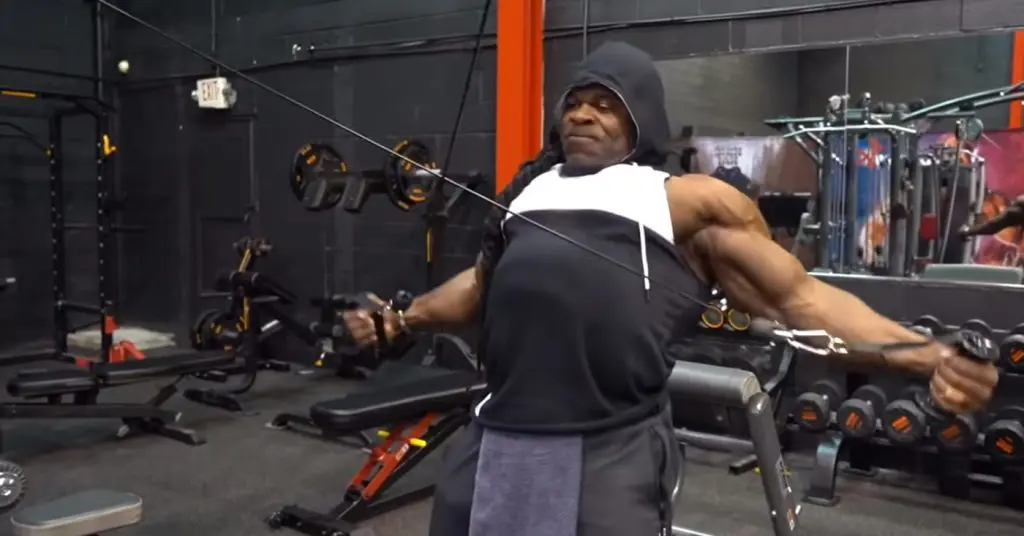
Exercise #3: Chest/bench-supported straight arm rear delt raises (1 set x 20 reps)
This exercise similar to exercise #1 but this time, Greene actually sat on the seat so that the bench (angled) supported his entire torso.
Exercise #4: Upright cable row using EZ bar (1 set x 20 reps)
Level Up Your Fitness: Join our 💪 strong community in Fitness Volt Newsletter. Get daily inspiration, expert-backed workouts, nutrition tips, the latest in strength sports, and the support you need to reach your goals. Subscribe for free!
The upright cable row is a very effective exercise for hitting the delts and traps. However, you want to be careful with this movement as it can cause shoulder impingement issues due to the shoulder rotation. Don’t go too heavy and if you feel pain, stop.
Afterward, Greene gave some very valuable training advice that applies to life as well…
“Now the secret with doing this movement isn’t just to get lost. Every rep, every set counts, and the only way you can milk the benefit is to squeeze. You got to think about the muscles that you want to hit and squeeze. Think about what they’re going to look like when you’re done working and squeeze.
And when the world is pressing in on your with their objections and sh-t, with questions that you may not be able to answer at the time, and you wonder what can I do, help me, I remember just to squeeze. I think about these muscles I want to work, and I squeeze. I think about the sh-t that I want to do and I squeeze, I think about the things that I want to become and I squeeze.”
Repeat exercise #3 – (15 reps)
Repeat exercise #4 – (15 reps)
Repeat exercise #3 – (12 reps)
Repeat exercise #4 – (12 reps)
“These traps, rhomboids, rear delts… I need that on my physique,” he said after the last set for the rear muscles. “That’s one of those areas that I need to focus on even if I’m just playing around“.
And then, he moved on to the front and side delts.
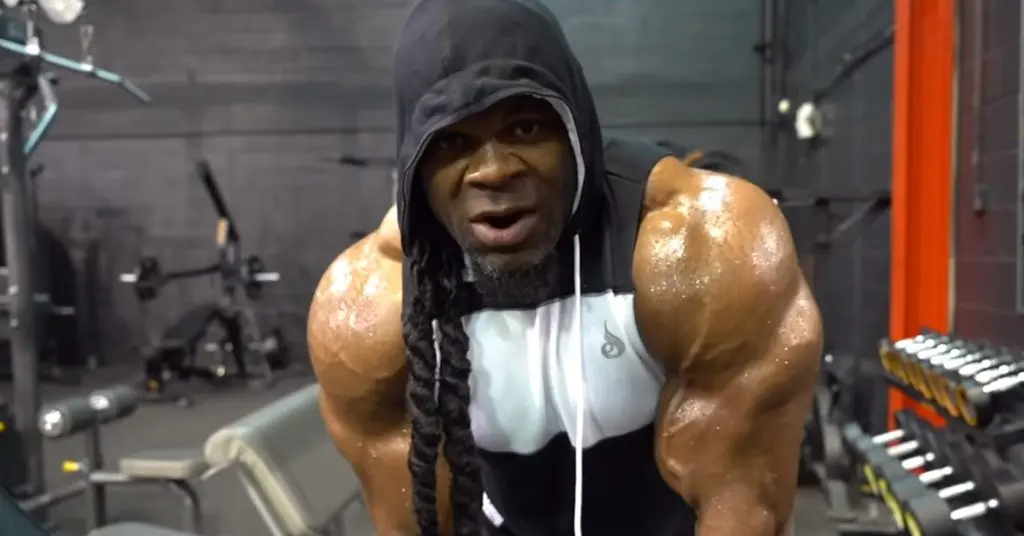
Front and side delts
Exercise #1: Angled front/side delt raises superset (10 reps each)
To hit the front or anterior and side or lateral delts, Kai Green leaned his back up against an angled bench and performed 10 reps of front raises followed by 10 reps of side raises.
Then after he finished tying his fancy shoes that he showed off, Greene began the next set, increasing the weight.
Exercise #2: Angled side raises/front raise variation superset (15 sets each)
To vary up the angles, Greene performed the side raise with his arms hanging behind his body. He then followed this up with a front raise variation where he touched the ends of the dumbbells together for a better contraction.
In between sets, he talked about how it’s not crazy to talk to yourself or to answer yourself. “Ain’t nothing crazy about talking to yourself. Ain’t nothing crazy about reminding yourself that you have someone to talk to”. He says it’s a very effective way to see help yourself to see yourself through a situation.
Repeat exercise #2 in reverse: Angled front raise variation/side raises superset (12 reps each)
This exercise concluded the workout and Kai Greene had more words of wisdom to finish off the session.
Final words of wisdom
“A bodybuilder is able to build his physique, why, because he learns how to call and respond. The only way you’re able to see the manifestations of anything that I’ve been able to do with my body and my career is because I was able to learn how to call and respond.”
“You can’t become the best in yourself unless you learn how to call and respond accordingly. You can’t depend on somebody else to tell you when you need to be responsible and accountable with how you use the resource that is yours.”
“That’s not responsible thinking and when you act responsibly that means you understand that you are powerful. I can use my mind to create or I can destroy, you get me. Learning how to talk to yourself, learning how to listen to yourself, learning how to hear when you need help, learning how to understand what some of the behavioral practices are that say hey man I’m crying out.”
“I need to take a little bit more time with listening to me, hearing me. That stuff is real and that is something that has taken me a long time to really understand as vividly as I do. But because I have it, I’m able to discipline my thinking, turn off my feelings if need be. Overcome the challenges of how I feel when they present the obstacles that don’t allow me to see things clearly.”
“And because I’m able to do that I’m able to redirect my thinking to where I want it to be. This is a thinking man’s practice.”
That’s a wrap!




